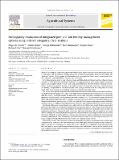| dc.description.abstract | Maize is becoming the major food crop around Lake Victoria. Major constraints to its production are Striga, stem borer, and declining soil fertility. Innovative integrated technologies have been developed: the ‘push–pull’ system (intercropping with Desmodium and surrounded by Napier grass), soybean and Crotalaria rotations, and imidazolinone-resistant (IR) maize seed.
In 12 demonstration trials in four villages in Siaya and Vihiga districts (Kenya) and two villages in Busia (Uganda) in 2003 and 2004, 504 farmers evaluated all cropping systems and a mono-cropped continuous maize, each cropped with IR or local maize, and supplemented or not with fertilizer, totaling 16 treatments. Farmers evaluated all treatments for yield, resistance to Striga and stem borer, improvement of soil fertility, and provided an overall evaluation score, using an ordered scale of 1 (very poor) to 5 (very good). Data were analyzed using ordinal regression, estimating log odds ratios.
The results show significant preferences for all treatments over the control. Push-pull with IR and fertilizer had the highest log odds ratio (2.93), so the odds of farmers preferring this treatment are 18.7 times the odds that farmers prefer the control. The odds ratios for the other push-pull combinations were generally highest (9–15), followed by the rotation systems with Crotalaria (3.5–7.0), and soybeans, especially with IR maize and fertilizer (odds ratio of 5.7). In mono-cropping systems, IR maize was only appreciated in combination with fertilizer, and then only in 2004. Push-pull and Crotalaria were more appreciated in 2004 than in 2003. Farmers in Vihiga had a stronger preference for push-pull, and those in Busia for soybean rotations.
Significant differences among farmers were observed, but the effects were small. Women appreciated push-pull more than men, while other technologies were gender-neutral. Older farmers were more likely to prefer push–pull and Crotalaria with fertilizer. Livestock ownership was not found to have an effect on technology preferences. Measured yield, stem borer and Striga infestation all had significant but small effects, although their inclusion did not eliminate the treatment effects, indicating that other factors are still important. OLS of the scores for different criteria on the overall score shows yield to be the most important criterion (coefficient of 0.40), followed by soil fertility enhancement (0.25) and Striga resistance (0.13). Labor saving (0.09) and stem borer resistance (0.03) are relatively minor criteria.
This research shows that scoring and analysis with ordinal regression is a convenient way to solicit and analyze farmers’ preferences for new technologies, with wide applicability in farming systems and participatory research. Its application here shows that farmers like the new technologies, especially push-pull, but that there are substantial differences between years, sites and farmers. The use of this method can be very helpful to define and focus further research and formulate specific and targeted recommendations for agricultural extension. | en_US |

